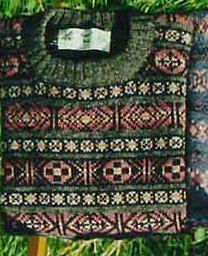 | ||
Fair Isle is a traditional knitting technique used to create patterns with multiple colours. It is named after Fair Isle, a tiny island in the north of Scotland, that forms part of the Shetland islands. Fair Isle knitting gained a considerable popularity when the Prince of Wales (later to become Edward VIII) wore Fair Isle tank tops in public in 1921. Traditional Fair Isle patterns have a limited palette of five or so colours, use only two colours per row, are worked in the round, and limit the length of a run of any particular colour.
Some people use the term "Fair Isle" to refer to any colourwork knitting where stitches are knit alternately in various colours, with the unused colours stranded across the back of the work. Others use the term "stranded colourwork" for the generic technique, and reserve the term "Fair Isle" for the characteristic patterns of the Shetland Islands.
Other techniques for knitting in colour include intarsia, slip-stitch colour (also known as mosaic knitting).
Technique
Basic two-colour Fair Isle requires no new techniques beyond the basic knit stitch. (The purl stitch is not used if circular knitting needles or 3 double-pointed needles are used.) At each knit stitch, there are two available "active" colours of yarn; one is drawn through to make the knit stitch, and the other is simply held behind the piece, carried as a loose strand of yarn behind the just-made stitch. To avoid "loose" strands larger than 3-5 stitches, the yarn not in use can be "caught" by the yarn in use without this being seen on the front of the work - see below. Knitters who are comfortable with both English style and Continental style knitting can carry one colour with their right hand and one with their left, although it is also possible to simply use two different fingers for the two colours of yarn and knit both using the same style.
The simplest Fair Isle pattern uses circular or double pointed needles, cast on any number of stitches. Knitting then continues round and round, with the colours alternated every stitch. If the pattern is started with an even number of stitches, a vertically striped tube of fabric will be formed, while an odd number will create a diagonal grid that appears to mix the two colours.
Traditional Fair Isle patterns normally had no more than two or three consecutive stitches of any given colour, because they were stranded, and too many consecutive stitches of one colour means a very long strand of the other, quite easy to catch with a finger or button. A more modern variation is woven Fair Isle, where the unused strand is held in slightly different positions relative to the needles and thereby woven into the fabric, still invisible from the front, but trapped closely against the back of the piece. This permits a nearly limitless variety of patterns with considerably larger blocks of colour.
Traditionally Fair Isle jumper construction involves knitting the body of the jumper completely in the round. Steeks are worked across the armhole openings allowing the body to be completed in the round without interruption. Once the main body of the jumper is complete, the armhole steeks are cut open (sometimes these are secured before cutting). Stitches are then picked up around the armhole opening and the sleeve is knitted down toward the cuff in the round. ("Steek" from the Scottish word meaning 'stitch', 'to close shut'. A knitted steek is formed of several stitches. The technique was first developed in the Shetland Isles.)
Beginning in the 1990s, the term "Fair Isle" has been applied very generally and loosely to any stranded colour knitting regardless of its relation to the knitting of Fair Isle or any of the other Shetland Islands.
